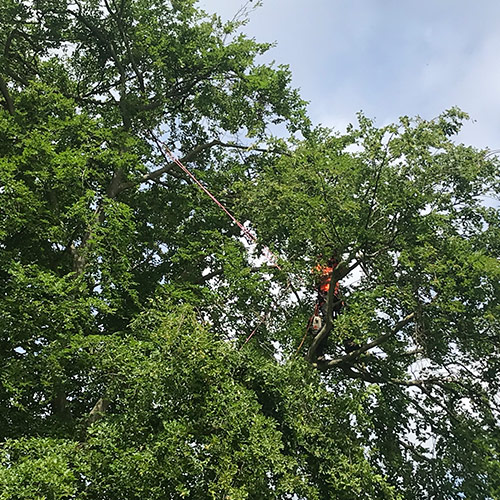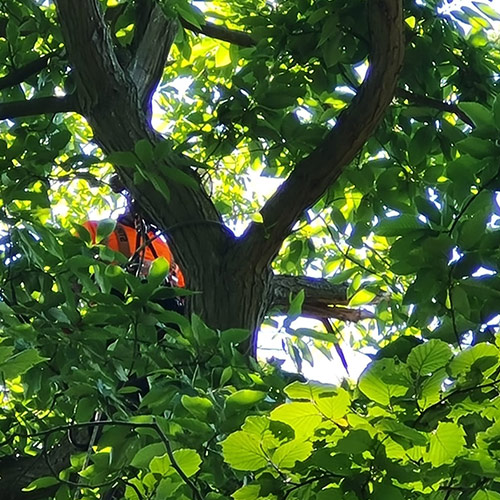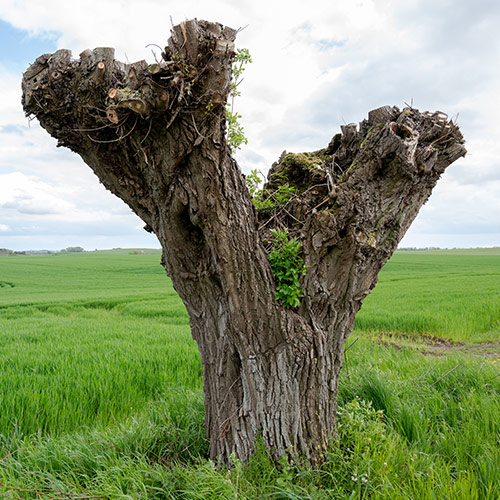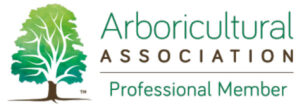Tree Surgery
Ace Of Spades Tree Care
We are a nation of tree lovers, however, sometimes trees require surgery to reduce the size, take weight out of the canopy, a reshape, or sometimes as a last resort they need to come down.
Trees provide a wide variety of benefits to society, but they are living organisms that naturally shed branches or fall. Although the overall risk to human safety is very low, tree owners have a legal duty of care.
When a tree presents a risk following storm damage, has a poor structure, or is decayed, property owners are legally required to manage the risk they pose to others.,
Professional, Qualified Advice
We offer professional, qualified expertise to help take a balanced and proportionate approach to managing the risk of trees.
Do you need permission before you go ahead with tree surgery? We can help you with your application to your local authority if there is a TPO (tree protection order) or a conservation area order in place.
All works comply with British Standard 3998:2010
Tree Surgery Services
Tree Pruning
Tree pruning is a tree maintenance procedure which is used to maintain a high level of structural integrity. There are different types of tree pruning techniques which are species specific, seasonally specific, and can be defined by the safety or the management of the tree.
You may need to have a tree pruned following recommendations from a safety survey or for corrective or preventative measures. Current thinking is too much pruning of a tree to reduce the safety factor may actually increase the risk from decay, there is therefore a balance to be struck. The level and type of pruning varies between different species, there are some trees that should not be pruned.
Trees that receive the correct structural pruning when young will require less corrective pruning as they mature.




Tree Removal
Tree removal is either the process of cutting down trees in a single section where space allows and is carried out when either tree becomes unstable and can present serious safety issues or is unsuitable for its location.
A variety of methods and expertise are used to ensure the direction of the fall of the tree and this work should only ever be carried out by qualified professional arborists. Before felling a tree, we will always explore other options including pruning and pollarding.
If a tree is on your land you do not need permission to fell unless it is subject to a tree preservation order (TPO), or in a conservation area. To compensate for the loss of a tree we recommend planting a new one and this maybe a condition of planning agreement.
Consideration should be given to the type of species in relation to size, suitability to other tree nearby, hypoallergenic effects, aftercare and mitigation with regard to climate change. We are happy to offer advice on choosing the best species for the environment.
Crown Thinning
Crown thinning is the removal of a portion of branches to produce a uniform density of foliage around an evenly spaced branch structure. It is a method often used to alleviate disease and decay, to allow more light and air to pass through the tree, reduce wind resistance and reduce weight. It is also used within a mature tree which has previously been badly pruned.
It can be used to formatively adjust the structure and shape of a tree by pruning them during their life cycle ideally when they are young or semi mature but before maturity. It is a way of taking out features that can mechanically cause a problem or create risk or decay.
This is unlikely to be a one-time only procedure, particularly on species that produce large quantities of branches also known as epicormic growth.


Crown lifting of a tree canopy
Crown lifting is the removal of the lowest branches of a tree to lift the height of the crown base. It is often used to create a higher tree canopy, keep branches away from traffic, or to open a view.
Crown lifting of some species of trees is not recommended and if carried out incorrectly can cause biomechanical loading and failure of the tree. This method of tree maintenance is species specific, and we would always consider a range of options to reduce any potential harm to the tree.
Crown lifting can invigorate a tree by redirecting energy resources and can help to breath life into an older unproductive tree.
Coppicing
Coppicing of trees is an ancient forestry technique of managing trees and hedgerows, which allows for infinite harvesting of wood from your land without the need to replant. It is species specific and seasonally specific.
In a coppiced wood, which is called a copse, young tree stems are repeatedly cut down to near ground level, resulting in a stool. New growth emerges, and after a number of years, the coppiced tree is harvested, and the cycle begins once again.
The length of the rotational cycle will depend on the tree species, as well as the projected use of the product, a typical rotation might be on a cycle of 7 – 8 years. Trees being coppiced cannot die of old age as coppicing maintains the tree at a juvenile stage, allowing them to reach immense ages.
Historically coppicing has been used to produce wood for firewood, charcoal, and fodder for cattle


Pollarding
Pollarding is a type of pruning, which is species specific, that keeps trees and shrubs smaller than they would naturally grow.
Generally, once the pattern is formed you re-prune to the previous pollard points depending on the safety of the tree, it is way of ensuring longevity of the tree beyond its normal life cycle.
Another reason for pollarding is to maintain a smaller tree to abate indirect effects of the tree to build structures, such a subsidence, and to manage your crown shape to keep the crown small. Often there is allowance for seasonal summer growth to give some shading from the tree or a screen during the summer months.
Whether or not we are able to pollard your tree depends on the species of trees, your space, and the age of your trees.





